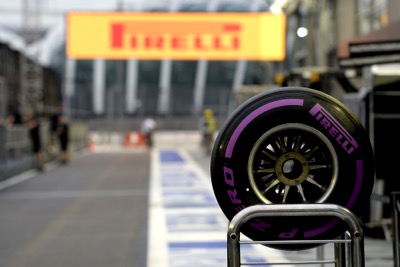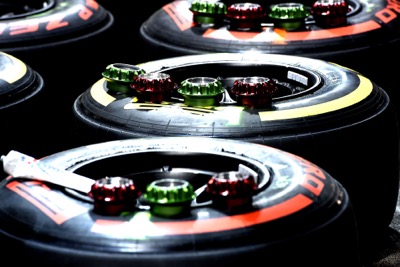Paul Hembery is Pirelli motorsport director, a person responsible for suppling tires to Formula 1 teams. This year his company introduced an extra, ultra-soft compound, as well as allowed driver to choose 3 types of them per each Grand Prix, what definitely made races more exciting. Pirelli is preparing some more changes for the next year - the tires will be bigger what will let drivers set faster lap times by 2 seconds per lap compare to this season. Now that is Paul’s main time-consuming activity, but during Singapore Grand Prix he managed to find some time for a conversation with Wojtek Paprota about his job in F1.
Paul, first off all, can you tell us how is the season going from Pirelli’s point of view?
It is a very interesting season because this year more than ever we got a big focus already on next season because of the changes that are coming to the sport. We are obviously continuing to be at the races, have the 3 compounds coming this season which have made quite an interesting development in terms of strategy during the races. We got a huge eye looking already on the next year and that means it is different than most years. We have always been looking for the following year, but due to the change of the tires’ size and the aerodynamic package we have been working on next years product since September last year.
This year you slightly modified your compounds and you also added a new one. What is the feedback you are given from the teams and drivers?
The ultra-soft was intended for street circuits, was to add an extra level of performance for street racing. We already have the performance improvement of the half a second to 0.7s over the super-soft. We would have liked more, to be honest, but we were unable to test it in the street circuits environments, so it was very difficult to understand what the true impact of the changes is. It is working, we have had races where it has played its role. We see here in Singapore for example that the qualifying is the choice of the tires and then it plays its role in the strategy of the race.
Why it is so important to the drivers to keep the certain tire pressure you give them before each Grand Prix?
As in road cars, tires’ pressures is a very important aspect of the performance of the vehicle, chassis and tire combination. We make many simulations by ourselves but when we get the data from the teams we have a simulation for each race because it is very dependent on the vehicle itself but also on the type of circuit that you have got. We then run our simulations and that comes up with the advisory for the pressures that you need to keep the tire to maintain the integrity of the product. On the Friday night we take the actual data from the running sessions of FP1 and FP2 and we compare it to the simulation data what we have been given before the race. With them we make a correction, or not, to the pressures on Saturday and Sunday. It is like a road car. When you open the door of the road car, you see a little picture of the car and it will have one picture that has one person on the road and the certain level of pressures. The other part of the spectrum is that when you have 4 people in the car with all the luggage, then you need another advisory of the pressures. The more load you put into the tire, the more pressure you need to maintain the performance of the product. So it is a simple function of the loading putting to the car.
As you said at the beginning, this season you are running test for 2017 tires and I am aware that you cannot share so much details about it, but can you just briefly say if you are happy with the way they go and if you will be able to finish them until November, as it was stated before the season?
I can see that from my point of view the tests have been very positive so far and we have managed to come up with solutions for the structure, the profile and the compounding that we are going to take forward for the next year and we are at the points of starting to refine our decisions for that. There is an issue that the cars are not yet replicating the downforce of the 2017 cars and that will probably bring forward the question mark to the choice of compounding because it has such a big influence on the way the compounds are being used. So until we get to the pre season tests, we won’t understand fully that the compound choices that we make are actually going to be the correct ones up to the end of the season. So we still have some question marks right up to the end. The structure, the profiles - that can all be done during the testing sessions that we have got and combining that with simulator, with our in-door testing, but we still can’t predict the performance of 2017 cars. What will be the question mark as I said, is going to be the compounding, that will be affected by the final version of the 2017 car.


Those tests are being done by three tope teams - Mercedes, Ferrari and Red Bull and and I hear a lot of opinions from the other drivers, journalist and technical directors from the other teams that it will create an advantage for those teams. What is your point of view for that?
There is many levels to discuss. One is that there is a full data exchange. All the date the testing teams have, the other teams have as well. The other thing is that the teams don’t know what they are testing, they haven’t got a clue what they are testing. They don’t know about the compounds, profiles, structures because we have mixed it up. No one team is even close to have the final product. Of course by the end of the day somebody says that they have an advantage. It is easy to say, but very difficult to proof. The reality is that he only people that are going to get the final product are the 11 teams and it will happen during pre-season tests in February. That’s an infinite product but they will have the same time until Melbourne to test the definite product.
Recently Pirelli chairman, Marco Tronchetti Provera said that your company wants top drivers to test the new tires. What is it so important to have top drivers on board and does it mean that you can’t get enough out of people like Sébastien Buemi or Pascal Wehrlein who used to do those tests?
Of course the top drivers, are the ones who are experienced and the ones who take the products to the extremes of performance. So it is quite logical that we want the best drivers to be testing our products. You can clearly see it from Ferrari and from the Mercedes from the next handling of testing we will probably see Nico or Lewis as well coming to assist. From Red Bull we don’t have an indication yet that we will see Max or Dani, but we will certainly prefer the ones who are the best.
2017 tires are going to be slightly bigger so the surface that is going to be sticked to the ground will be also bigger. Does it also mean that the tires will be more difficult to manage?
No, probably going in the opposite direction - easier to manage, because what we are working on is making the tires less sensitive so you won’t have the operation window issues that drivers have been struggling with for a couple of seasons. We try to change what we call combine traction which is the point at which you transfer from the breaking to acceleration within the corner, which the drivers perceive as the drivability. I believe that the tires themselves will be quite totally different next season.
Pirelli also supplies tires to GP2 and GP3 series that are Formula 1 supportive series. As you said, it is going to be a big change so it will create a big difference between those series. Do you also have a plan to introduce any changes there, as the new GP2 car is coming in 2018?
At the moment no. Of course when the new car comes in 2018 that might change so next year I am sure that we will be working on the new product for GP2. At the moment I think that they will remain as they are.




